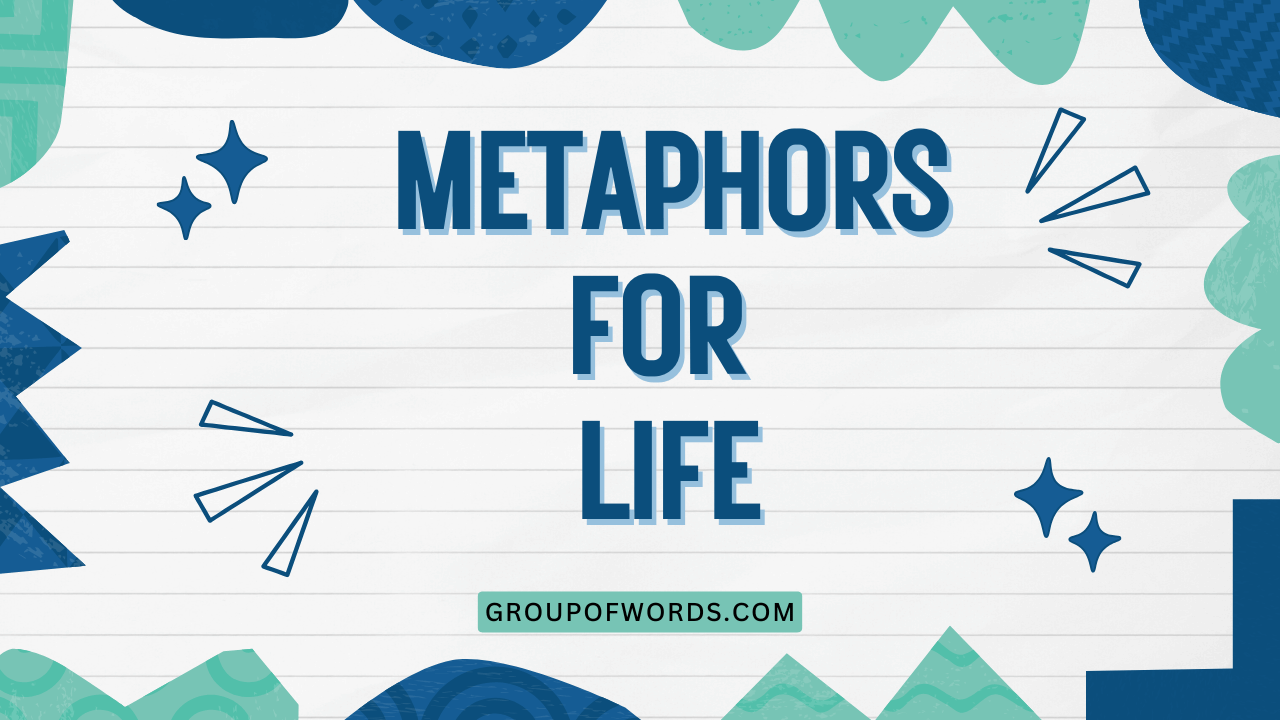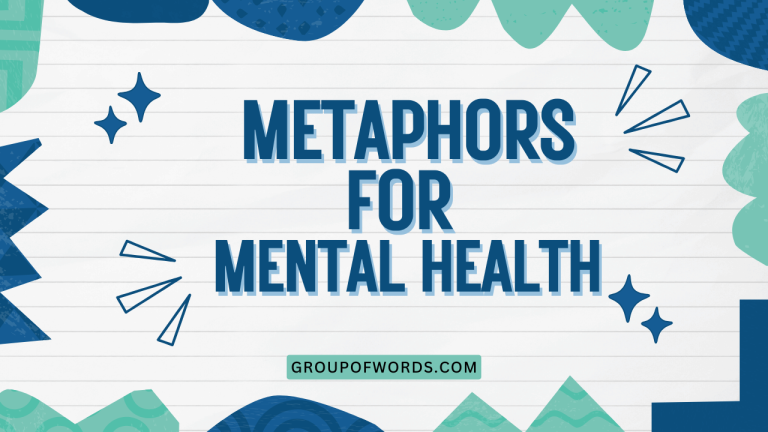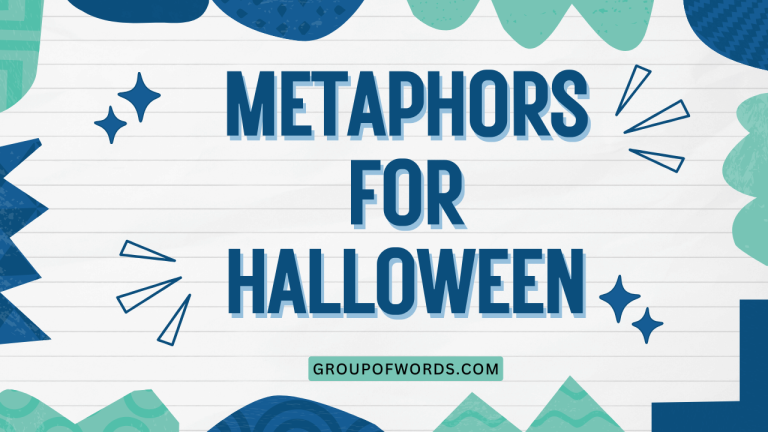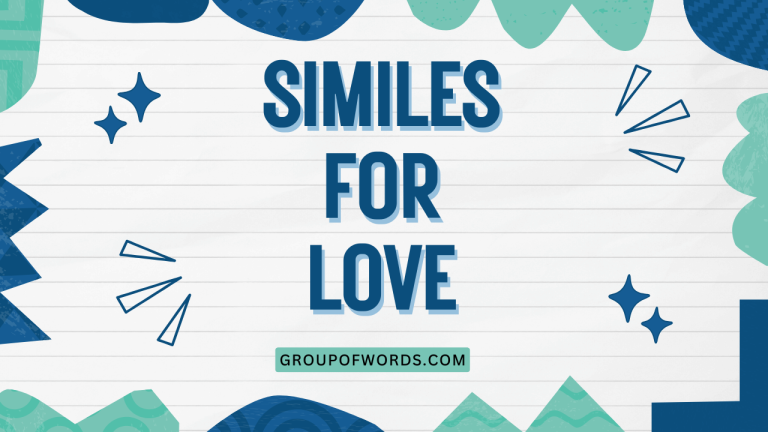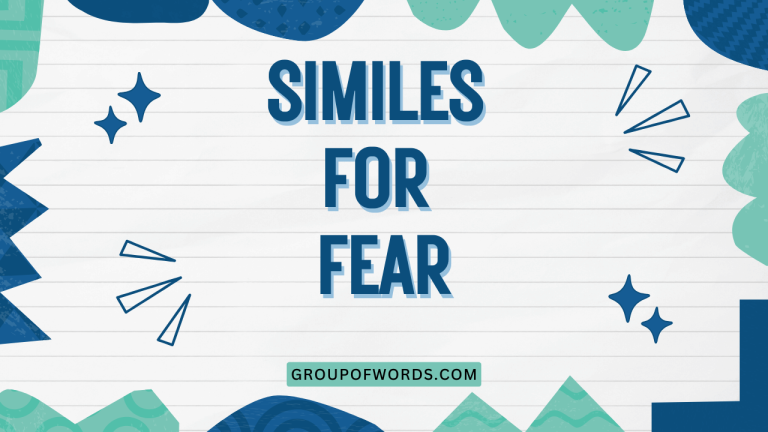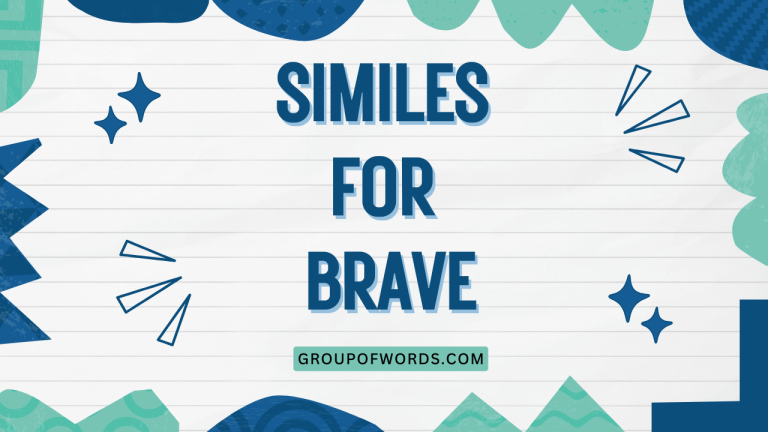Life as a Metaphor: Understanding Figurative Language
Metaphors are powerful tools in the English language, allowing us to understand abstract concepts by relating them to something more concrete. When we use metaphors to describe life, we gain deeper insights into its complexities, challenges, and opportunities.
This article will explore the various ways life is portrayed through metaphors, providing a comprehensive understanding of their structure, usage, and impact. Whether you’re an English language learner, a student of literature, or simply someone interested in the art of expression, this guide will equip you with the knowledge to appreciate and use life metaphors effectively.
Understanding metaphors for life enhances your comprehension of literature, poetry, and everyday conversations. It allows you to express yourself more creatively and vividly, adding depth and nuance to your communication.
This article will benefit anyone looking to improve their understanding of figurative language and its application in describing the human experience.
Table of Contents
- Introduction
- Definition of Metaphor for Life
- Classification of Metaphors
- Function of Metaphors in Describing Life
- Contexts of Use
- Structural Breakdown
- Tenor and Vehicle
- Implicit vs. Explicit Metaphors
- Types of Metaphors for Life
- Life as a Journey
- Life as a Game
- Life as a Stage
- Life as a Battle
- Life as a Garden
- Examples of Metaphors for Life
- Life as a Journey Examples
- Life as a Game Examples
- Life as a Stage Examples
- Life as a Battle Examples
- Life as a Garden Examples
- Usage Rules
- Appropriateness and Context
- Avoiding Clichés
- Common Mistakes
- Misunderstanding the Metaphor
- Mixed Metaphors
- Practice Exercises
- Exercise 1: Identifying Metaphors
- Exercise 2: Creating Metaphors
- Advanced Topics
- Extended Metaphors
- Philosophical Implications
- FAQ
- Conclusion
Definition of Metaphor for Life
A metaphor is a figure of speech that directly compares two unlike things without using “like” or “as.” It asserts that one thing *is* another, creating a vivid and often surprising connection. A metaphor for life, specifically, uses this comparison to describe the human experience, its challenges, and its potential.
These metaphors help us frame our understanding of life in relatable terms. They provide a lens through which we can interpret our experiences and find meaning.
For instance, saying “life is a journey” implies that there’s a path to follow, with destinations and obstacles along the way.
Classification of Metaphors
Metaphors can be classified in several ways, including:
- Standard Metaphors: Common and widely understood metaphors (e.g., “time is money”).
- Novel Metaphors: Original and creative metaphors that offer a fresh perspective.
- Dead Metaphors: Metaphors that have become so common that they are no longer recognized as figurative (e.g., “the leg of a table”).
- Conceptual Metaphors: Underlying systems of thought that shape how we understand abstract concepts (e.g., “argument is war”).
Function of Metaphors in Describing Life
Metaphors serve several key functions:
- Simplification: They simplify complex ideas by relating them to familiar concepts.
- Emotional Impact: They evoke emotions and create a deeper connection with the audience.
- Perspective: They offer a new way of looking at life’s experiences.
- Memorability: They make ideas more memorable and impactful.
Contexts of Use
Metaphors for life are used in various contexts:
- Literature: In poems, novels, and plays to convey themes and character development.
- Speeches: To inspire and motivate audiences.
- Everyday Conversation: To express feelings and opinions in a vivid way.
- Self-Reflection: To understand personal experiences and challenges.
Structural Breakdown
Understanding the structure of a metaphor is crucial for both interpreting and creating them effectively. The two key components are the tenor and the vehicle.
Tenor and Vehicle
The tenor is the subject being described (in this case, life). The vehicle is the object or concept used to describe the tenor. For example, in the metaphor “life is a rollercoaster,” life is the tenor, and rollercoaster is the vehicle. The vehicle provides a framework for understanding the tenor.
The relationship between the tenor and vehicle is what gives the metaphor its power. The shared characteristics or qualities between the two create the metaphorical meaning.
This allows us to transfer understanding from something familiar (the vehicle) to something less familiar or more abstract (the tenor).
Implicit vs. Explicit Metaphors
Metaphors can be either explicit (stated directly) or implicit (implied). An explicit metaphor directly states the comparison, like “life is a highway.” An implicit metaphor, on the other hand, suggests the comparison without directly stating it. For example, “He navigated the treacherous waters of his career” implicitly compares his career to a dangerous sea.
Implicit metaphors often require more interpretation from the reader or listener, but they can also be more subtle and impactful. Explicit metaphors are clearer but can sometimes lack the nuance of implicit ones.
Types of Metaphors for Life
There are several common metaphors used to describe life, each highlighting different aspects of the human experience.
Life as a Journey
This is one of the most prevalent metaphors. It suggests that life has a direction, with progress, setbacks, and destinations.
It emphasizes the importance of experience, learning, and growth along the way. The journey metaphor often includes concepts like paths, roads, maps, and guides.
This metaphor is powerful because it encourages a sense of purpose and direction. It implies that even when facing difficulties, there is still a path forward, and that each experience contributes to the overall journey.
Life as a Game
This metaphor focuses on rules, strategies, competition, and rewards. It highlights the challenges and opportunities that life presents, as well as the need for skill and perseverance.
The game metaphor can emphasize both the playful and serious aspects of life.
Seeing life as a game can encourage a more strategic and competitive approach. It can also help to frame setbacks as temporary losses, rather than permanent failures.
Life as a Stage
This metaphor, popularized by Shakespeare in *As You Like It*, emphasizes the performative aspects of life. It suggests that we play different roles throughout our lives, adapting to various situations and audiences.
The stage metaphor highlights the importance of presentation, perception, and identity.
This metaphor can be insightful in understanding how we present ourselves to the world and the different roles we inhabit. It can also lead to reflections on authenticity and the nature of identity.
Life as a Battle
This metaphor portrays life as a struggle against adversity. It emphasizes resilience, courage, and the need to overcome challenges.
The battle metaphor often includes concepts like enemies, weapons, strategies, and victories.
While this metaphor can be motivating, it’s important to use it with caution, as it can also create a sense of constant conflict and stress. However, it can be helpful in framing difficult situations as opportunities for growth and strength.
Life as a Garden
This metaphor focuses on growth, cultivation, and care. It suggests that life requires nurturing and attention to flourish.
The garden metaphor emphasizes the importance of patience, perseverance, and the environment.
This metaphor is particularly relevant in discussions of personal development and well-being. It highlights the need to create a supportive and nurturing environment for growth and to tend to our physical, emotional, and mental health.
Examples of Metaphors for Life
The following tables provide extensive examples of different types of metaphors used to describe life. Each table focuses on a specific metaphor, illustrating its various expressions and nuances.
Life as a Journey Examples
This table showcases how the “life as a journey” metaphor is used in different contexts. The examples illustrate the various aspects of a journey, such as paths, obstacles, and destinations, and how they relate to the human experience.
| Metaphor | Explanation |
|---|---|
| Life is a winding road. | Life has unexpected turns and challenges. |
| Life is a marathon, not a sprint. | Success requires endurance and long-term effort. |
| Life is a pilgrimage. | Life is a spiritual quest with a meaningful destination. |
| Life is a voyage across a vast ocean. | Life involves exploration and navigating unknown territories. |
| Life is a climb, but the view is great. | Life is challenging, but the rewards are worth the effort. |
| Life is a path filled with thorns and roses. | Life has both pain and beauty. |
| Life is a road less traveled. | Life involves making unique choices and forging your own path. |
| Life is a journey of self-discovery. | Life is about learning and growing as an individual. |
| Life is a scenic route. | Life is about enjoying the present moment and appreciating the beauty around you. |
| Life is a race against time. | Life is a constant effort to achieve goals before time runs out. |
| Life is an uphill battle. | Life presents constant challenges that require effort to overcome. |
| Life is a rollercoaster of emotions. | Life involves highs and lows, ups and downs. |
| Life is a long and winding staircase. | Life involves gradual progress and many steps to reach a goal. |
| Life is a series of crossroads. | Life involves making important decisions that shape the future. |
| Life is a trek through the wilderness. | Life involves navigating uncertain and challenging environments. |
| Life is a meandering river. | Life flows in unexpected directions, shaped by external forces. |
| Life is a long walk home. | Life is a journey back to oneself and finding inner peace. |
| Life is an expedition into the unknown. | Life is filled with mysteries and opportunities for exploration. |
| Life is a winding mountain path. | Life is challenging, but reaching the summit is rewarding. |
| Life is a carousel of dreams. | Life involves chasing aspirations that are always just out of reach. |
| Life is a scenic route. | Life is about savoring the simple joys and beauty around us. |
| Life is a treasure hunt. | Life is a quest for valuable experiences and meaningful connections. |
| Life is a voyage of discovery. | Life is a continuous exploration of oneself and the world. |
| Life is a cross-country race. | Life requires stamina and determination to overcome obstacles. |
| Life is a climb towards enlightenment. | Life is a spiritual journey of gradual awakening and understanding. |
Life as a Game Examples
This table explores the “life as a game” metaphor, highlighting the rules, strategies, and challenges involved. These examples emphasize the competitive and strategic aspects of life.
| Metaphor | Explanation |
|---|---|
| Life is a chess game. | Life requires strategic thinking and planning. |
| Life is a gamble. | Life involves taking risks and hoping for the best. |
| Life is a poker game. | Life requires bluffing and knowing when to hold or fold. |
| Life is a game of chance. | Life is influenced by luck and unpredictable events. |
| Life is a game of give and take. | Life requires compromise and reciprocity. |
| Life is a high-stakes game. | Life involves significant consequences for success or failure. |
| Life is a game with no reset button. | Life’s decisions are permanent and irreversible. |
| Life is a game of survival. | Life involves adapting to challenging circumstances to endure. |
| Life is a board game with complex rules. | Life is governed by intricate social and cultural norms. |
| Life is a competition for success. | Life is a constant striving to achieve goals and surpass others. |
| Life is a game of cat and mouse. | Life is a pursuit where someone is always trying to outsmart another. |
| Life is a game of strategy and luck. | Life requires both careful planning and being in the right place at the right time. |
| Life is a game where the rules are constantly changing. | Life requires adaptability and the ability to learn new strategies quickly. |
| Life is a game of winners and losers. | Life often results in some people succeeding while others fall behind. |
| Life is a game of skill and perseverance. | Life rewards those who develop their abilities and never give up. |
| Life is a game of patience. | Life requires waiting for the right opportunities and being persistent. |
| Life is a game of give and take. | Life requires balance and reciprocity in relationships and interactions. |
| Life is a game of risk and reward. | Life involves weighing potential gains against possible losses. |
| Life is a game of masks and mirrors. | Life involves presenting different personas to different people. |
| Life is a game of chance and choice. | Life’s outcomes are influenced by both unpredictable events and personal decisions. |
| Life is a game of survival of the fittest. | Life favors those who are most adaptable and resilient. |
| Life is a game of love and war. | Life involves both passionate connections and fierce competition. |
| Life is a game of deception and truth. | Life requires discerning what is real from what is fake. |
| Life is a game of hope and despair. | Life involves experiencing both moments of optimism and times of sadness. |
Life as a Stage Examples
This table presents examples of the “life as a stage” metaphor, focusing on roles, performances, and the audience. These metaphors emphasize the performative and theatrical aspects of human behavior.
| Metaphor | Explanation |
|---|---|
| Life is a stage, and we are merely players. | Life is a performance where we play different roles. |
| Life is a play with many acts. | Life is divided into different phases and experiences. |
| Life is an improvisation. | Life requires spontaneity and adaptability. |
| Life is a drama filled with conflicts and resolutions. | Life involves challenges and overcoming them. |
| Life is a comedy with moments of tragedy. | Life involves both humor and sadness. |
| Life is a one-man show. | Life is an individual journey with unique experiences. |
| Life is a grand performance. | Life is a significant and impactful experience. |
| Life is a dress rehearsal for eternity. | Life is a preparation for something greater. |
| Life is a stage where everyone wears a mask. | Life often involves hiding true feelings and presenting a curated image. |
| Life is a play with an unpredictable script. | Life’s events are often unexpected and cannot be fully controlled. |
| Life is a performance under constant scrutiny. | Life involves being watched and judged by others. |
| Life is a theater of dreams and illusions. | Life can be filled with aspirations and fantasies that may not come true. |
| Life is a show where the audience never leaves. | Life’s experiences are continuous and always leave an impact. |
| Life is a stage for triumphs and failures. | Life presents opportunities for both success and setbacks. |
| Life is a play of shadows and light. | Life involves both dark and bright moments. |
| Life is a performance of love and loss. | Life is characterized by deep connections and inevitable separations. |
| Life is a drama of choices and consequences. | Life’s outcomes are shaped by the decisions we make. |
| Life is a theater of the absurd. | Life can often seem meaningless and illogical. |
| Life is a script we write as we go along. | Life’s narrative is created through our actions and experiences. |
| Life is a stage where we play many roles. | Life involves adapting to different situations and relationships. |
| Life is a play of fate and free will. | Life’s events are influenced by both destiny and personal agency. |
| Life is a performance of courage and vulnerability. | Life requires both strength and openness. |
Life as a Battle Examples
This table contains examples that use the “life as a battle” metaphor, emphasizing struggle, conflict, and resilience. The examples illustrate the challenges and adversities faced in life.
| Metaphor | Explanation |
|---|---|
| Life is a battle against adversity. | Life is a constant struggle against challenges. |
| Life is a war against time. | Life is a race to achieve goals before time runs out. |
| Life is a fight for survival. | Life is a struggle to endure and overcome obstacles. |
| Life is a battlefield of emotions. | Life involves managing and overcoming internal conflicts. |
| Life is a constant struggle. | Life is filled with challenges and hardships. |
| Life is a war zone filled with casualties. | Life can be destructive and leave lasting scars. |
| Life is an ongoing conflict with our inner demons. | Life involves battling personal weaknesses and negative thoughts. |
| Life is a fight for justice. | Life involves advocating for fairness and equality. |
| Life is a battle of wits. | Life requires intelligence and strategic thinking to succeed. |
| Life is a struggle for identity. | Life involves discovering and asserting one’s true self. |
| Life is a war against mediocrity. | Life involves striving for excellence and avoiding complacency. |
| Life is a battle for happiness. | Life involves actively pursuing joy and contentment. |
| Life is a fight against despair. | Life involves resisting negative emotions and maintaining hope. |
| Life is a war against ignorance. | Life involves seeking knowledge and understanding. |
| Life is a battle of wills. | Life involves asserting one’s desires and resisting opposition. |
| Life is a conflict between good and evil. | Life involves making moral choices and fighting against wrongdoing. |
| Life is a struggle for meaning. | Life involves searching for purpose and significance. |
| Life is a war against conformity. | Life involves resisting societal pressures and being true to oneself. |
| Life is a battle for survival of the fittest. | Life favors those who are most adaptable and resilient. |
| Life is a combat against our fears. | Life involves facing and overcoming personal anxieties. |
| Life is a struggle to find peace. | Life involves seeking inner harmony and tranquility. |
| Life is a war within ourselves. | Life involves internal conflicts and self-doubt. |
Life as a Garden Examples
This table presents examples of the “life as a garden” metaphor, emphasizing growth, nurturing, and care. These metaphors illustrate the importance of cultivation and attention to flourish.
| Metaphor | Explanation |
|---|---|
| Life is a garden; you reap what you sow. | Life rewards effort and hard work. |
| Life is a garden that needs constant tending. | Life requires ongoing care and attention. |
| Life is a garden of opportunities. | Life is full of potential and possibilities. |
| Life is a garden filled with weeds and flowers. | Life has both positive and negative aspects. |
| Life is a garden where dreams blossom. | Life is a place where aspirations can come true. |
| Life is a garden that needs watering with love. | Life requires nurturing relationships and connections. |
| Life is a garden where patience bears fruit. | Life rewards perseverance and long-term effort. |
| Life is a garden of experiences. | Life is a collection of diverse and enriching moments. |
| Life is a garden where you plant seeds of kindness. | Life is an opportunity to spread goodwill and compassion. |
| Life is a garden where you cultivate your potential. | Life is a chance to develop your talents and abilities. |
| Life is a garden that reflects your care. | Life’s quality is a direct result of the effort you invest. |
| Life is a garden where you prune away negativity. | Life involves removing harmful influences and thoughts. |
| Life is a garden that teaches you about growth. | Life offers lessons on personal development and resilience. |
| Life is a garden where you harvest wisdom. | Life provides opportunities to gain knowledge and understanding. |
| Life is a garden that blooms in every season. | Life offers beauty and opportunities in every stage. |
| Life is a garden where you nurture your soul. | Life involves caring for your emotional and spiritual well-being. |
| Life is a garden where you cultivate peace. | Life is a journey towards inner harmony and tranquility. |
| Life is a garden of memories. | Life is a collection of cherished experiences and moments. |
| Life is a garden where you sow the seeds of the future. | Life is an opportunity to create a positive legacy. |
| Life is a garden where you find beauty in simplicity. | Life offers joy in the small, everyday moments. |
| Life is a garden that rewards dedication. | Life is fulfilling for those who commit to their goals. |
| Life is a garden where you grow stronger roots. | Life provides experiences that build resilience and stability. |
| Life is a garden where you share your harvest. | Life is enriched by generosity and giving back to others. |
Usage Rules
Using metaphors effectively requires understanding certain rules and guidelines.
Appropriateness and Context
The appropriateness of a metaphor depends on the context and audience. Consider the tone and purpose of your communication.
A formal setting may require more conventional metaphors, while a creative context allows for more originality. Ensure that the metaphor resonates with your audience and enhances their understanding, rather than confusing them.
Be mindful of cultural differences and sensitivities. A metaphor that is meaningful in one culture may not translate well to another.
Always strive for clarity and relevance in your metaphorical expressions.
Avoiding Clichés
Cliches are overused metaphors that have lost their impact. While they may be easily understood, they lack originality and can make your writing or speech sound uninspired.
Strive to create fresh and original metaphors that offer a unique perspective.
Instead of saying “life is a rollercoaster,” which is a cliché, try something more specific and evocative, such as “life is a rickety wooden rollercoaster, full of unexpected drops and thrilling turns.” This adds depth and originality to your expression.
Common Mistakes
Several common mistakes can undermine the effectiveness of metaphors.
Misunderstanding the Metaphor
One common mistake is misunderstanding the underlying meaning of a metaphor. Ensure that you fully grasp the connection between the tenor and the vehicle before using a metaphor.
A misunderstanding can lead to miscommunication and confusion.
For instance, if someone says “life is a puzzle,” make sure you understand the intended meaning. Is it about finding the right pieces, solving a mystery, or fitting in?
Clarify the specific aspect of the puzzle that relates to life to avoid misinterpretation.
Mixed Metaphors
A mixed metaphor combines two or more inconsistent metaphors, creating a nonsensical or confusing image. For example, “We need to nip it in the bud before it snowballs out of control” mixes the metaphors of gardening and snow, resulting in a confusing and illogical statement.
To avoid mixed metaphors, ensure that all the images and concepts within your metaphor are consistent and coherent. Choose one central metaphor and develop it fully, rather than combining disparate elements.
Practice Exercises
These exercises will help you practice identifying and creating metaphors for life.
Exercise 1: Identifying Metaphors
Identify the metaphor in each sentence and explain what two things are being compared.
| Question | Answer |
|---|---|
| 1. Her life was an open book. | Metaphor: Life is an open book. Comparison: Life and a book are compared, suggesting that her life is easily understood and transparent. |
| 2. He was drowning in a sea of despair. | Metaphor: Despair is a sea. Comparison: Despair and a sea are compared, suggesting that he is overwhelmed by sadness. |
| 3. Life is a dance. | Metaphor: Life is a dance. Comparison: Life and a dance are compared, suggesting that life involves movement, rhythm, and grace. |
| 4. The world is my oyster. | Metaphor: The world is an oyster. Comparison: The world and an oyster are compared, suggesting that the world is full of opportunities. |
| 5. Time is a thief. | Metaphor: Time is a thief. Comparison: Time and a thief are compared, suggesting that time steals away moments and opportunities. |
| 6. His words were a soothing balm to her wounded spirit. | Metaphor: Words are a soothing balm. Comparison: Words and a balm are compared, suggesting that his words had a healing effect. |
| 7. The city is a jungle. | Metaphor: The city is a jungle. Comparison: The city and a jungle are compared, suggesting that the city is wild, dangerous, and competitive. |
| 8. Their relationship was a tangled web. | Metaphor: Relationship is a tangled web. Comparison: Relationship and a web are compared, suggesting that their relationship is complex and difficult to unravel. |
| 9. Education is the key to success. | Metaphor: Education is the key. Comparison: Education and a key are compared, suggesting that education unlocks opportunities and success. |
| 10. Life is a symphony of experiences. | Metaphor: Life is a symphony. Comparison: Life and a symphony are compared, suggesting that life is a harmonious blend of diverse experiences. |
Exercise 2: Creating Metaphors
Create a metaphor for life based on the given topic. Explain your metaphor.
| Topic | Metaphor | Explanation |
|---|---|---|
| Weather | Life is a storm, but there’s always a rainbow after the rain. | Life can be turbulent and challenging, but there is always hope and beauty after difficult times. |
| Building | Life is a construction project; you build it brick by brick. | Life requires effort and planning, and it is built gradually over time. |
| River | Life is a river, constantly flowing and changing. | Life is dynamic and unpredictable, with continuous movement and transformation. |
| Painting | Life is a canvas, and you are the artist. | Life is an opportunity to create your own masterpiece, with freedom and creativity. |
| Music | Life is a song, with highs and lows, fast and slow tempos. | Life is a mixture of different experiences and emotions, creating a unique melody. |
| Cooking | Life is a recipe; you mix different ingredients to create something unique. | Life involves combining various elements and experiences to create a unique individual identity. |
| Gardening | Life is a garden; you plant seeds of kindness and watch them grow. | Life involves nurturing positive qualities and relationships to create a fulfilling existence. |
| Navigation | Life is a map, and you must find your own way. | Life requires making choices and navigating challenges to reach your goals. |
| Architecture | Life is a blueprint, and you design your destiny. | Life involves planning and creating your own future, with intention and purpose. |
| Photography | Life is a photograph, capturing moments in time. | Life is a collection of memories and experiences that shape our perspective. |
Advanced Topics
For advanced learners, exploring extended metaphors and their philosophical implications can deepen your understanding.
Extended Metaphors
An extended metaphor is a metaphor that is developed over several lines or even throughout an entire work. It allows for a more complex and nuanced comparison, creating a richer and more impactful image.
For example, a poem might use the metaphor of “life as a garden” and
continue to explore this metaphor throughout the poem, discussing the different types of plants, the seasons, and the gardener’s role. This creates a cohesive and meaningful representation of life’s various aspects.
Extended metaphors are powerful literary devices that can add depth and complexity to your writing. They require careful planning and execution but can result in a more profound and memorable impact on the reader.
Philosophical Implications
Metaphors for life often reflect underlying philosophical beliefs and assumptions. For example, the metaphor of “life as a journey” implies a sense of purpose and direction, aligning with teleological views of existence.
The metaphor of “life as a game” suggests a more competitive and strategic approach, resonating with certain ethical frameworks.
Exploring the philosophical implications of life metaphors can lead to deeper insights into your own beliefs and values. It can also help you understand how different metaphors shape our perceptions of reality and influence our actions.
Consider the following questions:
- What assumptions does each metaphor make about human nature?
- How does each metaphor influence our understanding of success and failure?
- What are the ethical implications of each metaphor?
FAQ
Here are some frequently asked questions about metaphors for life.
Why are metaphors useful in understanding life?
Metaphors simplify complex ideas, provide emotional impact, and offer new perspectives, making life’s experiences more relatable and understandable.
How can I avoid using clichés in my metaphors?
Strive for originality by creating fresh and specific comparisons, focusing on unique aspects of the tenor and vehicle.
What is the difference between a metaphor and a simile?
A metaphor directly equates two unlike things (e.g., “life is a journey”), while a simile uses “like” or “as” to make a comparison (e.g., “life is like a journey”).
Can a metaphor be too complex?
Yes, a metaphor should be clear and understandable. If it requires too much interpretation, it may lose its effectiveness.
How do metaphors influence our perception of reality?
Metaphors shape our understanding of abstract concepts by framing them in relatable terms, influencing our beliefs, values, and actions.
What role do metaphors play in literature and poetry?
Metaphors add depth, imagery, and emotional resonance to literary works, enhancing themes and character development.
How can I improve my ability to create effective metaphors?
Practice identifying metaphors, analyze their structure, and experiment with different comparisons to develop your creative skills.
Are there any cultures that don’t use metaphors?
Metaphorical thinking is a universal aspect of human cognition, though the specific metaphors used may vary across cultures.
How do implicit metaphors add depth to writing?
Implicit metaphors add subtlety and nuance, requiring readers to actively engage in interpreting the comparison, which can be more impactful.
What is an example of a metaphor for overcoming adversity?
Life is a phoenix rising from the ashes, symbolizing resilience and the ability to overcome challenges and emerge stronger.
Conclusion
Metaphors for life offer a powerful means of understanding and expressing the human experience. By simplifying complex ideas, evoking emotions, and providing fresh perspectives, metaphors enrich our communication and deepen our self-awareness.
Whether you’re analyzing literature, crafting speeches, or simply reflecting on your own life, mastering the art of metaphorical expression will enhance your ability to connect with others and find meaning in the world around you.
Continue to explore the diverse range of life metaphors, experiment with creating your own, and consider the philosophical implications they reflect. By doing so, you’ll unlock a deeper understanding of yourself and the world.
